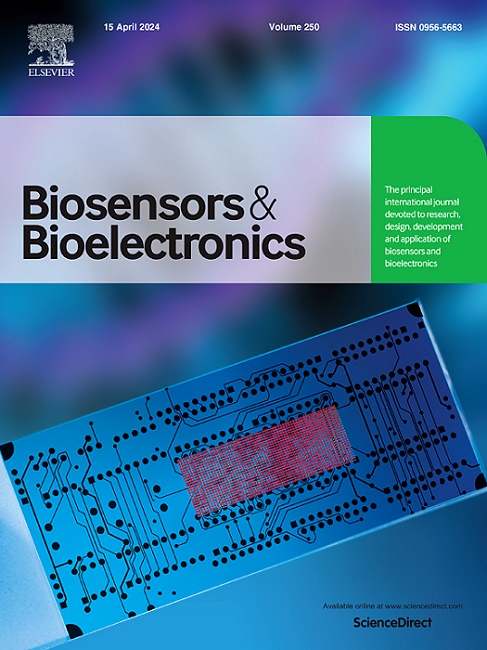An integrated electrochemical nanodevice for single-cell MiRNA-155 detection and drug evaluation
IF 10.5
1区 生物学
Q1 BIOPHYSICS
引用次数: 0
Abstract
Nanopipette-based platforms have emerged as a transformative tool for single-cell miRNA profiling and drug evaluation with the unique advantages of minimal invasiveness and high spatiotemporal resolution. Now the target detection and the drug delivery are separately operated with two steps, and the efflux of the cell results in a short intracellular retention of the drug molecules. In this paper, an integrated electrochemical nanodevice was fabricated for real-time monitoring of single-cell miRNA-155 and drug evaluation with one step, which was inserted into single cells by a three-dimensional micromanipulator. Upon exposure to miRNA-155, the stronger binding ability of the aptamer to miRNA-155 led to the detachment of Aptamer/HCOF/DOX from the nanopipette, changing the ionic current. Based on the ionic current, intracellular miRNA-155 level could be accurately quantified. The relative expression levels of miRNA-155 were calculated to be approximately 165.5 pM, 55.60 pM, 16.05 pM for single MDA-MB-231, MCF-7, and MCF-10A cells, respectively. Moreover, under the tumor acid microenvironment, the pH-sensitive HCOF structure facilitated controlled DOX release, allowing dynamic assessment of drug effects at the single-cell level, while minimizing off-target toxicity in normal cells due to microenvironment-specific drug activation. Due to the relative long retention time of the drug, the physiological changes of cells under different times of drug action could also be studied. This study highlights the potential of integrated electrochemical nanodevice for tracking and understanding the role of microRNA in screening new anticancer drug.
一种用于单细胞MiRNA-155检测和药物评价的集成电化学纳米器件
基于纳米管的平台已经成为单细胞miRNA分析和药物评估的变革性工具,具有微创和高时空分辨率的独特优势。现在的靶标检测和给药是分两步进行的,细胞的外排导致药物分子在细胞内停留的时间很短。本论文制作了一种用于单细胞miRNA-155实时监测和药物评价的集成电化学纳米器件,通过三维微机械臂插入单细胞。暴露于miRNA-155后,适配体与miRNA-155的结合能力较强,导致适配体/HCOF/DOX从纳米管分离,改变离子电流。基于离子电流,可以准确定量细胞内miRNA-155水平。计算miRNA-155在单个MDA-MB-231、MCF-7和MCF-10A细胞中的相对表达量分别约为165.5 pM、55.60 pM和16.05 pM。此外,在肿瘤酸微环境下,ph敏感的HCOF结构有助于控制DOX的释放,允许在单细胞水平上动态评估药物效应,同时最大限度地减少由于微环境特异性药物激活对正常细胞的脱靶毒性。由于药物的保留时间较长,因此也可以研究不同药物作用时间下细胞的生理变化。这项研究强调了集成电化学纳米器件在跟踪和理解microRNA在筛选新的抗癌药物中的作用方面的潜力。
本文章由计算机程序翻译,如有差异,请以英文原文为准。
求助全文
约1分钟内获得全文
求助全文
来源期刊

Biosensors and Bioelectronics
工程技术-电化学
CiteScore
20.80
自引率
7.10%
发文量
1006
审稿时长
29 days
期刊介绍:
Biosensors & Bioelectronics, along with its open access companion journal Biosensors & Bioelectronics: X, is the leading international publication in the field of biosensors and bioelectronics. It covers research, design, development, and application of biosensors, which are analytical devices incorporating biological materials with physicochemical transducers. These devices, including sensors, DNA chips, electronic noses, and lab-on-a-chip, produce digital signals proportional to specific analytes. Examples include immunosensors and enzyme-based biosensors, applied in various fields such as medicine, environmental monitoring, and food industry. The journal also focuses on molecular and supramolecular structures for enhancing device performance.
 求助内容:
求助内容: 应助结果提醒方式:
应助结果提醒方式:


